Percussion Instruments
African Talking Drum
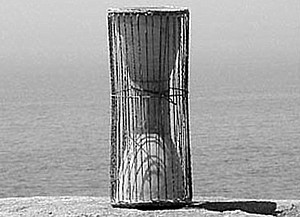
- Trouble's Braids (Swordfishtrombones - Victor Feldman, 1983)
A variable pitched instrument from Africa, the talking drum is held under one arm and squeezed while struck with a stick or mallet with the other hand. This hourglass shaped drum is loosely strung so that by squeezing it under the arm, the pitch gets higher, by letting go, the pitch gets lower. Traditionally it is from western Africa and is used in Ghana, especially by the Ashanti people.
TW (1983): "It's (Trouble's Braids) Victor Feldman on African talking drum, Stephen Taylor on parade bass drum and Larry Taylor on acoustic bass." (Source: "A Conversation with Tom Waits (Swordfishtrombones)" Island Records music industry white label 12" promo. Date: September, 1983)
TW (1983): "I've always been afraid of percussion for some reason. I was afraid of things sounding like a train wreck, like Buddy Rich having a seizure. I've made some strides; the bass marimbas, the boobams, metal long longs, African talking drums and so on." (Source: "The Beat Goes On". Rock Bill magazine (USA). October 1983, by Kid Millions)
TW (1983): "Some of the stuff I think is a bit of a departure for me. Ehm... the instrumentation is all different, and no saxophones. I used the banjo, accordion, bass-marimba, ehm metal aunglongs ehm you know African squeeze drum, a calliope, a harmonium. Eh, so some of the stuff is a little more exotic." (Source: "Saturday Live Interview With Tom Waits Source: BBC Radio One (UK) by Richard Skinner. October 22, 1983)
Bass Drum
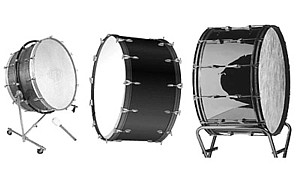
- Shore Leave (Swordfishtrombones - Victor Feldman, 1983)
- Trouble's Braids (Swordfishtrombones, 1983)
- Knife Chase (Blood Money, 2002)
A bass drum is a large kind of drums, having two heads, and emitting a deep, grave (bass) sound. The timpano is struck near the side to excite certain preferred modes. By contrast, the bass drum is struck in the center.The composer Mozart added the deep, booming, untuned sound of the bass drum to the orchestra in 1782. Constructed like a snare drum, but without snares, the bass drum is much larger and is played on its side, so that either head may be struck. The beater or mallet for a bass drum is large with a soft material such as sheep's wool covering the end.
TW (1983): "I tried to add some musical sound effects (Shore Leave) with the assistance of a low trombone to give a feeling of a bus going by, and metal aunglongs the sound of tin cans in the wind, or rice on the bass drum to give a feeling of the waves hitting the shore. Just to capture the mood more than anything of a marching marine or whatever walking down the wet street in Hong Kong and missing his wife back home." (Source: "A Conversation with Tom Waits (Swordfishtrombones)" Island Records music industry white label 12" promo. Date: September, 1983)
Bass Marimba
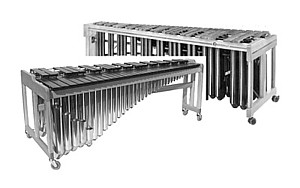
- Shore Leave (Swordfishtrombones, 1983)
- Underground (Swordfishtrombones, 1983)
The marimba is officially a member of the xylophone family with full length resonators below each bar. On top-of-the-line instruments the resonators are made of aluminum or some other metal and are carefully tuned to bring out the fundamental note of each bar. On more primitive instruments the resonators may be simply hollowed-out gourds. Marimbas are made with wooden keys. They are often made with an African hardwood called Padauk. Other woods such as Mahogany, Wenge, even Yew or Cedar are sometimes used. There are 4 different ranges of marimbas - soprano, tenor, baritone and bass - each playing its own part and rhythm. Harry Partch built his bBss marimba in 1950, near Gualala, California. It is 5 feet high (the player stands on a riser) and 7.5 feet long. Resonators and frame are of redwood.
TW (1983): "The bass marimba is an instrument I've grown very fond of lately." (Source: "The Beat Goes On". Rock Bill magazine (USA). October 1983, by Kid Millions)
TW (1983): "Some of the stuff I think is a bit of a departure for me. Ehm... the instrumentation is all different, and no saxophones. I used the banjo, accordion, bass-marimba, ehm metal aunglongs ehm you know African squeeze drum, a calliope, a harmonium. Eh, so some of the stuff is a little more exotic." (Source: "Saturday Live Interview With Tom Waits Source: BBC Radio One (UK) by Richard Skinner. October 22, 1983)
TW (1983): "I've always been afraid of percussion for some reason. I was afraid of things sounding like a train wreck, like Buddy Rich having a seizure. I've made some strides; the bass marimbas, the boobams, metal long longs, African talking drums and so on." (Source: "The Beat Goes On". Rock Bill magazine (USA). October 1983, by Kid Millions)
Bell Plate
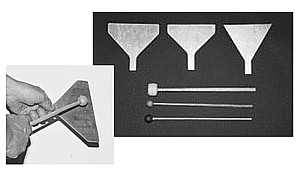
- 16 Shells From A Thirty-Ought-Six (Swordfishtrombones - Victor Feldman, 1983)
A steel plate suspended with gut or heavy wire and played with a hard beater. It can be used as a substitute for an anvil, church bell, fire bell, train bell, etc. Bell plates (sold commercially as Belleplates) are metal plates that, when struck, ring with a strong initial transient, followed by a nearly pure decaying sinusoidal tone (they ring for tens of seconds when struck). They are played like handbells but are rather cheaper and less loud.
TW (1983): "I tried to get a 'chain gang work song'-feel holler (16 Shells From A Thirty-Ought-Six). Get a low trombone to give a feeling of a freight train going by. It's Stephen Hodges on drums, Larry Taylor on acoustic bass, Fred Tackett on electric guitar, Victor Feldman on brake drum and bell plate and Joe Romano on trombone." (Source: "A Conversation with Tom Waits (Swordfishtrombones)" Island Records music industry white label 12" promo. Date: September, 1983)
TW (1983): "16 Shells - I wanted a chain gang sort of a feel -banging a hammer on an anvil - Huuh - like a work song - Huuh, used brake drum and bell plate and tried to take it outside - certain instruments bring you indoors, other instruments take you outdoors, trying to get that kind of feel on it" (Source: unidentified Swordfishtrombones Interview. 1983/ 1984)
Bongos
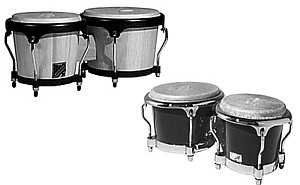
- Michael Blair (Big Time, 1988)
- Everything Goes To Hell (Blood Money, 2002)
Bongo is the term for a variety of small drums, derived from African roots, most likely in Cuba around 1900. It consists of a pair of unequal sized small drums that are joined together. The smaller drum is called the "male", or minor drum, while the larger is the "female" or major drum. Bongos are an integral part of Latin percussion, particularly as a solo instrument. They are mainly played sitting down, held between the knees. In the 1920's the bongos were lower tuned than they are today, and played with a technique more reminiscent of conga drumming, including tabla-like pitch changes. The skins were tacked on, and to maintain the tuning the "bongocero" would use a small charcoal brazier which he kept by his feet. The modern bongo is tuned much higher as befitting its role as the soloist in the Latin rhythm section.
Boobams
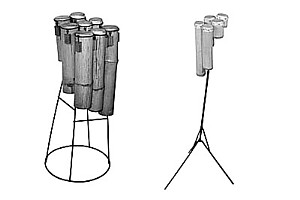
- ...?... (Swordfishtrombones, 1983)
Boobams (bamboo reversed syllabically) are tuned bongos constructed with a shell of natural bamboo. The available width and depth of the shell, which contributes to the desired pitch, is limited only by the size of available bamboo found typically in the tropical islands of the Pacific Ocean. Although boobams appear as ethnic drums in these areas, the modern instrument found its way into current use through its appearance on numerous recordings in Hollywood beginning in the 1950s. A modern version of boobams, using synthetic or wood shells not of bamboo, is marketed under the trade name of Octobans. Two sets of boobams, constructed for Harry Partch by Bill Loughbrough, were owned and used by Shelly Manne for numerous recording sessions in the Los Angeles studios.
TW (1983): "I've always been afraid of percussion for some reason. I was afraid of things sounding like a train wreck, like Buddy Rich having a seizure. I've made some strides; the bass marimbas, the boobams, metal long longs, African talking drums and so on." (Source: "The Beat Goes On". Rock Bill magazine (USA). October 1983, by Kid Millions)
RR: "Waits had gone from a sax-bass-guitar-drums configuration to using everything from Balinese metal aunglongs, pump organs and banjos to bass boo-bams and bagpipes." (Source: "Waits In Wonderland" Image magazine/ San Francisco Examiner (USA), by Rip Rense. Date: December 13, 1992)
Brake Drum
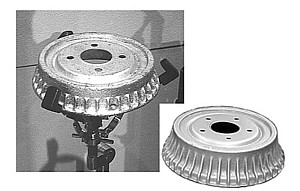
- 16 Shells From A Thirty-Ought-Six (Swordfishtrombones - Victor Feldman, 1983)
- Michael Blair (Big Time, 1988)
Unpitched metal percussion (a suspended steel circle from a vehicle brake, producing a clear, penetrating tone when struck). The actual brake cylinder from an automobile. When struck with a hard mallet, it gives a clear, bell-like tone. Sometimes it is tuned to a specific pitch by grinding. They can be suspended for best resonance or laid out on a padded table. Common substitute for an orchestral anvil.
TW (1983): "I tried to get a 'chain gang work song'-feel holler (16 Shells From A Thirty-Ought-Six). Get a low trombone to give a feeling of a freight train going by. It's Stephen Hodges on drums, Larry Taylor on acoustic bass, Fred Tackett on electric guitar, Victor Feldman on brake drum and bell plate and Joe Romano on trombone." (Source: "A Conversation with Tom Waits (Swordfishtrombones)" Island Records music industry white label 12" promo. Date: September, 1983)
TW (1983): "16 Shells - I wanted a chain gang sort of a feel -banging a hammer on an anvil - Huuh - like a work song - Huuh, used brake drum and bell plate and tried to take it outside - certain instruments bring you indoors, other instruments take you outdoors, trying to get that kind of feel on it" (Source: unidentified Swordfishtrombones Interview. 1983/ 1984)
Bug
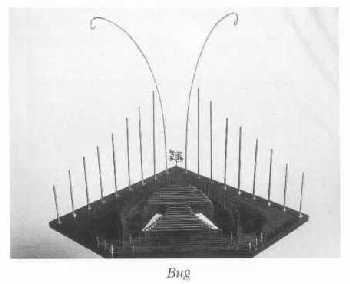
- Ali Husseini (Alice theatre play, 1992)
- Also featured on Moanin' Parade & Swarm Warnings (Gatmo, 2000)
An electro-acoustic percussion board (designed and manufactured by Bay area musician Tom Nunn) that is played with plastic-tubing tipped aluminum knitting needles, and sounds like a combination of marimba and thumb piano.
TW (1992): "There's a guy up there named Tom Nunn in San Francisco. He built something called a T-rodimba and another thing called the Bug. It's a 3/4 inch plywood sound base and these enormous metal rods that come out of it. It sounds like - it's like metal and wood, somewhere in the middle of metal and wood. It has a great sound. So I'm always listening for that stuff." (Source: "KCRW-FM: Evening becomes Eclectic" KCRW-FM radio. Santa Monica. October 9, 1992)
Chimes
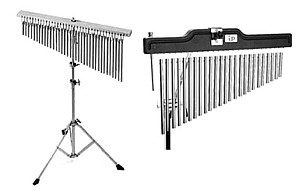
- Saving All My Love For You (Heartattack And Vine - Victor Feldman, 1980)
Chimes are a tuned instrument consisting of a set of 12 to 18 metal tubes hung from a metal frame. The metal tubes range from 1 to 2 � inches in diameter and from 4 to 6 feet in length. The chimes, or tubular bells, are struck with a mallet and sound like church bells when played. The longer the length of tube that is struck, the lower the pitch that is created.
Conga
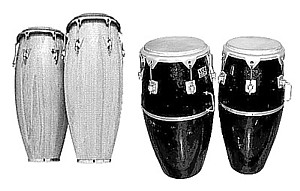
- Romeo Is Bleeding (Blue Valentine, 1978)
- ...?... (Swordfishtrombones, 1983)
- Jockey Full Of Bourbon (Rain Dogs, 1985)
- Straight To The Top - Rhumba (Franks Wild Years, 1987)
- Temptation (Franks Wild Years, 1987)
- Willie Schwarz (Big Time, 1988)
- Gospel Train (The Black Rider, 1993)
Of Cuban origin, this drum has a medium low sound. There are four different sizes of conga drums. The largest is called the tumba, and the smallest is called the ni�o. Nowadays, conga drums are made out of fiberglass as well as wood. In its present form, the conga has a tuneable skin. The sounds are controlled by wrist movements. tones can be played by either the heel of the hand or by one or more fingers. In addition to such tones, the drum head can be slapped.
Conundrum
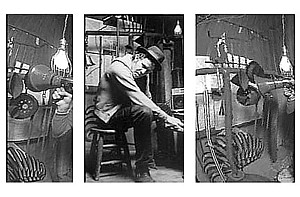
- In The Colosseum (Bone Machine, 1992)
Percussion rack with metal objects. Made for Waits by Serge Etienne.
TW (1992): "I wanted to explore more machinery sounds." So Waits commissioned a percussion rack called the Conundrum. TW: "It looks like some kind of perverted giant Spanish iron cross or something." The results include "In the Colosseum," which sounds like someone's hammering and clamoring in the next room, and "The Ocean Doesn't Want Me," a Ken Nordine-meets-Sea Hunt recitation about a foiled suicide attempt, haunted by the muffled clang of a giant iron chain knocking against an underwater pier. (Source: "Composer, musician, performer, actor Tom Waits..." Pulse!: Derk Richardson. September, 1992)
TW (1992): "I have a lot of violent impulses. It gets channeled into music. I like to play drums when I'm angry. At home I have a metal instrument called a conundrum with a lot of things hanging off it that I've found - metal objects - and I like playing it with a hammer. I love it. Drumming is therapeutic. I wish I'd found it when I was younger." (Source: "Tom Waits at work in the fields of the song" Reflex, issue 28: Peter Orr. October 6, 1992)
TW (1992): "On this (In The Colosseum) we used the Conundrum. This was an instrument that was built for me by a neighbour of mine who's a sculptor and a welder. It's just an iron cross with a lot of metal hanging off of it. it sounds like a jail door closing behind you." (Source: "KCRW-FM: Evening becomes Eclectic" KCRW-FM radio. Santa Monica. October 9, 1992)
TW (1992): "Serge Ettienne built that (Conondrum), a friend of mine. It was, it's really... It's just a metal configuration, like a metal cross. It looks a little bit like a Chinese torture device. It's a simple thing, but it makes... It give you access to these alternative sound sources. Hit 'em with a hammer. Sounds like a jail door. Closing. Behind you. I like it. You end up with bloody knuckles, when you play it. You just, you hit it with a hammer until you just, you can't hit it any more. It's a great feeling to hit something like that. Really just, slam it as hard as you can with a hammer. It's good therapeutic, and all that." (Source: "KCRW-FM: Morning becomes Eclectic" KCRW-FM radio. Santa Monica. October 12, 1992)
JJ (1992): "And that metal frame with the metal pieces on it that you were playing yesterday? TW: The conundrum. JJ: The conundrum? It's something you built? TW: No, Serge Etienne, a guy that lives right here. (points out the car window) JJ: In fact is that Serge right there? TW: That's Serge. JJ: The guy in the t-shirt? TW: Yeah... JJ: He's got some motor bikes back there, too. TW: Yeah, he drives motorcycles. He created a car out of a motorbike. He built a car frame around a...motorcycle. Out of fiberglass and styrofoam, and it's very light. It looks like those cars that we saw at the carnival the other night going around on the little track. JJ: And the conundrum...did you find those metal pieces and have him make it for you, or did he build the instrument himself? TW: He built it and gave it to me as a gift. I said I need some sounds I can use in the studio that are just metal sounds, a variety and range of vibrations I can use. It really does sound like a jail door closing if you hit it right. JJ: Yeah. It sounded amazing. So many different sounds out of it." (Source: "Tom Waits Meets Jim Jarmusch" Straight No Chaser magazine (UK) Vol. 1, Issue 20 Jim Jarmusch. October, 1992 (published early 1993))
TW (1992): "I like things that weren't intended to be instruments being used as instruments. Things that have never been hit before. So I'm always looking for those things; things that have been out in a field somewhere, or that you find in the gutter. I bring those things home. Well, I had a couple of things built. The thing that's called a conundrum, it looks like a big iron crucifix, and there are a lot of different things that we hang off of it. Crowbars, Tijuana sabers, and found metal objects that I like the sound of. It's a sideline of mine. People have been doing that for years. If you don't like the sound of the drums, you hit the music stand or the chair, or the wall. Or put the microphone in the bathroom and slam the toilet seat down. This is older than dirt, you know. If the room is right, you can get a great sound out of anything." (Source: "Bone Machine Press Kit" Island press kit. Rip Rense. Late 1992)
RR (1992): "As it is, "Bone Machine" utilizes, among other items, clattering sticks, an ancestor of the synthesizer called a Chamberlain, violin and accordion (played by Los Lobos' David Hidalgo) and a device Waits commissioned called a "conundrum" - rusted pieces of farm equipment hung from a huge iron cross that are beat upon and otherwise "played." -." (Source: "Waits in Wonderland" Image: Rip Rense. December 13, 1992)
RP (1993): "Ever since his film score for Mr. Coppola's "One From the Heart" (1982) and his own ground-breaking album "Swordfishtrombones" (1983), he has been resolutely broadening his musical palette, gravitating toward odd instruments (including a wheezing old proto-synthesizer called the chamberlain and a percussive sound sculpture known as the conundrum) and sonic textures." (Source: "Tom Waits, All-Purpose Troubadour" Robert Palmer, The New York Times: November 14, 1993)
Dabuki Drum
- Victor Feldman (Swordfishtrombones, 1983)
Frame Drum
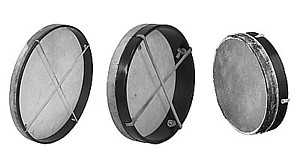
- Kommeniezuspadt (Alice, 2002)
Technically, a frame drum is a drum that has a shell depth smaller than the diameter of the drumhead, which can be from 6" to 20" (15 cm to 50 cm) or more. Frame drums are perhaps one of the earliest forms of drum made by many civilizations across the world, in essence they are a piece of animal skin stretched over a circular frame that has a depth less than the width of the head.Most cultures have some type of frame drum; the Egyptian Riq, the Brazilian pandeiro, the kanjira from south India, the middle eastern tar and bendir ,and the native American versions are but a few of the available frame drums. Of course, the frame drum most Westerners are familiar with is the good old tamborine. Not all frame drums are round. In Ghana, for example, there's a square frame drum called a tamalin, used in playing certain types of Ashante and Ewe music. square and rectangular frame drums are also found in China and other parts of the far east. Some frame drums have jingles, others do not. A variety of playing techniques can be used, based on different styles from various cultures.
Freedom Bell
- Town With No Cheer (Swordfishtrombones, 1983)
TW (1983): "That's a freedom bell (Town With No Cheer) upfront just trying to get a feel of a ghost town, tumbleweeds and that kind of thing." (Source: "A Conversation with Tom Waits (Swordfishtrombones)" Island Records music industry white label 12" promo. Date: September, 1983)
Glockenspiel (Orchestra Bells)
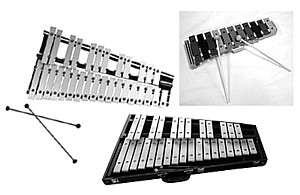
- Jersey Girl (Heartattack And Vine, 1980)
- Presents (One From The Heart, 1982)
- Blow Wind Blow (Franks Wild Years, 1987)
- More Than Rain (Franks Wild Years, 1987)
- Kenneth Agerholm (Woyzeck theatre play, 2000)
- Fish & Bird (Toy Glockenspiel. Alice, 2002)
One of the best known and simplest of orchestral percussion instruments, the Glockenspiel is a run of steel bars, tuned and laid out in a keyboard style. Its origins and earliest uses are unclear. The range of a standard orchestral instrument are 2.5 octaves F to C. Steel is generally the construction material for the notes although various alloys have been tried with differing effects. The sticks used also vary widely; some have brass balls as heads, others are hard rubber, pyralene or plastic. Repertoire: Orff - Carimna Burana, Mahler - Symphony No 3.
Log Drum
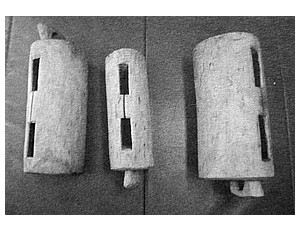
- God's Away On Business (Blood Money, 2002)
Originating in Africa, the log drum was literally a log that had been carved out, with one or two tongues of wood of differing lengths that is the striking point. In Africa these were used for communicating. The modern Log drums are basically the same technology except the design and sound has been significantly changed. Modern Log drums are two pieces of wood that are carved and then stuck together unlike the original African versions. Many contemporary composers have written for log drums including Stockhausen and Boulez and they are now a regular instrument within the 20th Century repertoire. Although they are not designed to be tuned, several composers have experimented with chromatic runs of Log drums.
Marimba
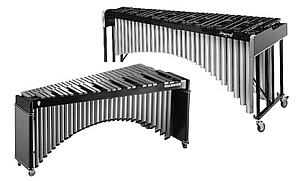
- Shore Leave (Swordfishtrombones, 1983)
- Clap Hands (Rain Dogs, 1985)
- I'll Be Gone (Franks Wild Years, 1987)
- Ali Husseini (Alice theatre play, 1992)
- Bent Clausen (Woyzeck theatre play, 2000)
- Fawn (Alice, 2002)
- Misery Is The River Of The World (Blood Money, 2002)
- All The World Is Green (Blood Money, 2002)
- Another Man's Vine (Blood Money, 2002)
- A Good man Is Hard To Find (Blood Money, 2002)
- Bent Clausen (The Black Rider theatre play, 2004)
- Caroline Hall (The Black Rider theatre play, 2002)
- Also featured on Moanin' Parade & Swarm Warnings (Gatmo, 2000)
The marimba is officially a member of the xylophone family with full length resonators below each bar. On top-of-the-line instruments the resonators are made of aluminum or some other metal and are carefully tuned to bring out the fundamental note of each bar. On more primitive instruments the resonators may be simply hollowed-out gourds. Marimbas are made with wooden keys. They are often made with an African hardwood called Padauk. Other woods such as Mahogany, Wenge, even Yew or Cedar are sometimes used. There are 4 different ranges of marimbas - soprano, tenor, baritone and bass - each playing its own part and rhythm. The marimba is similar to a Xylophone, but more resonant, larger range (up to and including 5 octaves), and graduated bars. The marimba has longer resonators, (tubes under the bars), than the Xylophone.
Mouse Tambourine
- Alice/ Blood Money (only mentioned in pre-album press release, 2002. Not in liner notes)
RF (2002): "Instruments utilised include piano, cello, pump organ, hand bells, circular violin, spring drum, marimba, calliope, timpani and mouse tambourine. l ask about the mouse tambourine and he laughs. 'Oh, you know what,' he says, bending over and rolling up his right trouser leg 'See these boots here, they have this buckle,' He wiggles a small silver buckle at the top of his black motorcycle boot. 'Well, during most of the songs I was tapping my foot and there was a lot of room mics in the studio, and so when we listened back to all the songs my wife's going, "What the hell is that?! That *tsk tsk tsk...*"' We just couldn't figure it out. Finally, she said, "Dammit it's those boots. I told you not to wear those boots. It's on everything!" And she got so upset!' He laughs. 'We tried to get rid of it and couldn't, so finally we just had to call it the mouse tambourine." (Source: "Conformity is a fool's paradise" Time Out London (UK) by Ross Fortune. February/ March. Published: April 24 (- May 12), 2002)
Sticks
- Earth Died Screaming (Bone Machine, 1992)
TW (1992): "On 'The Earth Died Screaming,' we got sticks and we tried them everywhere. I wanted to try and get some of that sound of pygmy field recordings that I love so much, and we couldn't get it. We tried different places in the room, different microphones, nothing. Different kinds of sticks, sizes of sticks. And then we went outside and just put a microphone on the asphalt and there it was, boom, 'cause we were outside." (Source: "Composer, musician, performer, actor Tom Waits..." Pulse!: Derk Richardson. September, 1992)
TW (1992): "I like the Earth Died Screaming. We have a pygmy percussion unit on there called the Boners that we formed during the making of it and we recorded outside. Took the microphone outside onto the dirt and put it up and had everybody play sticks on the sidewalk cause we couldn't get the same sound in the studio. It's too resonant." (Source: "KCRW-FM: Evening becomes Eclectic" KCRW-FM radio. Santa Monica. October 9, 1992)
TW (1992): "That pygmy stuff that you sent me really flipped me! It really got me listening, because we struggled for a couple days with getting the sound of a stick orchestra inside the studio for "Earth Died Screaming". We tried every configuration and position of the microphone, and finally I said, "Well, why don't we go outside, isn't that where all these recordings are made?" And five minutes later we had a mike up, we were hitting it, it was there. It was that simple." JJ: Like out in the parking lot of the studio? TW: ...Right outside the door, yeah. JJ: What kind of sticks were you using? TW: Just 2 by 4's, anything we could find, logs from the firewood. About nine people. Just different people walking by. We'd say, "Come on, play some sticks!" But that pygmy music really sent me." (Source: "Tom Waits Meets Jim Jarmusch" Straight No Chaser magazine (UK) Vol. 1, Issue 20 Jim Jarmusch. October, 1992 (published early 1993))
T-Rodimba
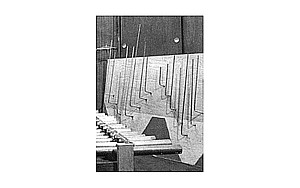
- Ali Husseini (Alice theatre play, 1992)
- Also featured on Moanin' Parade & Swarm Warnings (Gatmo, 2000)
The Octatonic T-Rodimba, is constructed from a 3/4 inch birch plywood sheet with 33 threaded steel rods bent at 90� angles attached to the board in groups of 11, forming three V shapes, with the largest rod at the bottom (center) and progressively shorter rods above. In addition to the rods there are three 'zing trees' (bronze rods bent to form small tree-like shapes embedded in the board, making gong-like sounds when struck), a pair of strings connected with a small steel washer, a line of finishing nails with random pitches along the bottom edge, textured surfaces for scraping, a loose fitting bolt to make chirping sounds, and a couple of aluminum discs the size of a CD which are scraped or struck. The implements used include 'stick mallets' made of wood dowel for striking the rods, combs and knitting needles for scraping, guitar picks to pluck and strum the nails or scrape the rods, [and] a small bow for bowing the strings and rods. The Octatonic T-Rodimba is amplified via two contact microphones on the back of the board.
TW (1992): "There's a guy up there named Tom Nunn in San Francisco. He built something called a T-rodimba and another thing called the Bug. It's a 3/4 inch plywood sound base and these enormous metal rods that come out of it. It sounds like - it's like metal and wood, somewhere in the middle of metal and wood. It has a great sound. So I'm always listening for that stuff." (Source: "KCRW-FM: Evening becomes Eclectic" KCRW-FM radio. Santa Monica. October 9, 1992)
RR (1992): "Moments prior to this interview, Waits was packing his suitcases with socks, underwear - and experimental musical instruments called Wind Wands, photon clarinets, PVC Membrane saxophones, a Waterphone and something called a T-Rodimba... The "Alice" instruments, Waits excitedly points out, were built by "real pioneers" of music living in the Bay Area: Richard Waters (the Waterphone, a polytonal metal instrument filled with water), Tom Nunn (the T-Rodimba, a conglomeration of plywood and hardware with a violin pick-up), Darrel DeVore (Wind Wands, "which sound like Orville and Wilbur"), Bart Hopkins (PVC Membrane saxophones, which are too complex to explain succinctly) and Reed Ghazala (photon clarinets, which are played by beams of light bouncing off light-sensitive keys)." (Source: "Waits in Wonderland" Image: Rip Rense. December 13, 1992)
Tuned Hand Bells
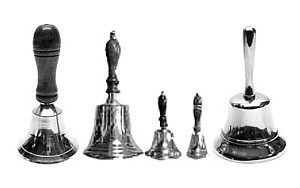
- Alice theatre play rehearsals (1992)
- Everything You Can Think (Alice, 2002)
With hand bells individual notes are played rather than a chord. Each bell represents a note. At the present time, four bell manufacturers produce handbells: Malmark, Schulmerich, John Taylor, and Whitechapel. Bell Plates are considerably less expensive than handbells. Many handbell techniques may be taught and used with Bell Plates, making this product an inexpensive way to introduce handbells/ handchimes to beginners.
Q (2000): And do you get to play with those European instruments that you enjoy so much? (for Alice theatre play). TW: "Yeah, the bass clarinet and hand bells. That's something I never experienced before, these hand bells. Mostly religious organizations use 'em. Tuned handbells. Everybody has one, and there's like eighteen of you and you ring consecutively and do Christmas music [laughs]. Like little carolers. We get those woven in there. Then there's usual stuff, the pump organ. So yeah, it's got that circus thing, waltzes." (Source: "Another Night At The Opera For Waits" Rolling Stone: Andrew Dansby. November 4, 2000)
JP (2002): "The music drags hymns and parlor songs, blues and ballads into a sonic menagerie that, on the new albums, includes Swiss hand bells, calliope and a four-foot-long Indonesian seed pod, which is "as wide as a Bible," he said, and has "seeds as big as CD's." (Source: "Tom Waits: A Poet of Outcasts Who's Come Inside" New York Times (USA) by Jon Pareles. Published: May 5, 2002)
Tymps (Timpani, Tympani, Kettledrums)
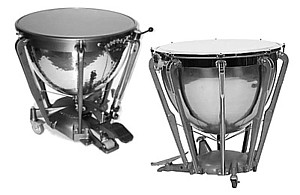
- You Can't Unring A Bell (One From The Heart - Victor Feldman, 1982)
- Everything Goes To Hell (Blood Money, 2002)
A set of kettledrums of different sizes, which play different notes. The timpano has a round head stretched over a sealed enclosure. The tension may be altered by means of a footpedal which actuates tensioning elements. The choice of striking point emphasizes the preferred modes of the circular membrane. The sounded frequencies are further influenced by the enclosed air cavity.

